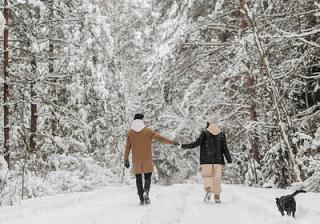
Author: Paul Gabrielsen
The COVID-19 pandemic has helped people rediscover the outdoors and enjoy the physical and mental health benefits that exposure to nature provides.
Scientists are still exploring how and why time in nature has such a beneficial effect. A new collaborative effort involving U professors Dorothy Schmalz, interim chair of the Department of Parks, Recreation and Tourism in the College of Health, Nalini Nadkarni, emeritus professor in the School of Biological Sciences, and Tim Brown, President and CEO of Tracy Aviary, aims to bring researchers and practitioners together to explore the connection between nature and human health. The effort is called Nature and Human Health-Utah, or NHH-UT. Find an announcement about NHH-UT funding opportunities and upcoming events here.
Tell us about the NHH-UT collaborative.
NHH-UT aims to bring together expert researchers and practitioners to address complex questions about the nature-human health connection and to develop innovative solutions to issues of use and access. We facilitate opportunities to share ideas and take action. We’re also excited to be able to provide funding for some pilot grants, which will be announced in 2022.
Why is Utah an ideal place to carry out this kind of research?
Utah is world-renowned for both its outdoor recreation and its capacity to carry out rigorous research on pressing societal and environmental questions. What better place to investigate the connection between nature and human health?
In 2019, Utah hosted nearly 11 million visitors to national parks and 4.5 million skiers. Although the pandemic resulted in fewer visitors, the hospitality and leisure industry in Utah outperformed those in other states.
But Utah’s outdoor recreation resources are not just for visitors—these opportunities make Utah a great place to live too, which is part of the appeal for corporations moving their headquarters to Utah and contributing to our growing economy. For example, in a survey of technical sector employees, 45% of transplants said that outdoor recreation was a recruitment tool used by their employer, and 79% said that outdoor recreation was the most important factor in their decision to move to Utah.
How does being in nature benefit our physical health?
We are naturally more active when we are outside, so the health benefits of activity are inherent. However, we are also breathing fresh air, stimulating our brains, clearing our minds and taking a break from our screens and stressors of the day. Research in many fields has documented benefits beyond physical health include better sleep, reduced depression, more prosocial behavior and improved cognitive development in children.
How does being in nature benefit our mental health? Why is this important during the pandemic?
Just taking a break from our normal routines by getting outside for 120 minutes a week (about 17 minutes a day) shows reduced anxiety and depression and improved productivity and mood. The pressures of the last 18 months have been especially hard on mental health. But being outside was one way that people could still interact while not risking exposure. We saw increased use of parks and outdoor resources for physical activity in many communities. People who might not have seen the value of outdoor recreation opportunities before started to see it during the pandemic. We need to capitalize on this momentum and seize this window of opportunity for outdoor recreation as a health care tool.
Not everyone can, for example, go on a hike on a Saturday to get into nature, for various reasons. What are other ways to get these health benefits?
Health benefits of nature are not limited to being physically active. Just getting out in it—walking in your neighborhood, meeting a friend in a local park or even having some plants in your house will have a positive effect on mood and well-being.
What are your tips for maintaining nature exposure through the winter?
Getting outside in the winter is not my favorite thing. It’s sometimes hard to get off the couch and go for a walk, but I’ve never regretted it when I’m done. Even though the temperatures are lower, the sun is often shining. Coming from the Northeast, I really appreciate how much sun we get throughout the winter months, so I try to get out and enjoy a sunny day, even if it is chilly. It helps having a dog of course.
It’s also important to prepare appropriately. If you’re not used to going outside during winter then start slowly and make mental notes that help you track what you’re wearing and what the temperatures are, whether its sunny or not, and humidity levels. There’s a lot of good clothing available to keep us warm and comfortable in winter and it makes all the difference!
And I’m not overlooking our air quality issues, which can make being outside unappealing if not impossible for some people. I would recommend that everyone bring the outside in with houseplants. If you’re like me and have trouble keeping up with them, get some resilient plants like succulents which can withstand a little neglect.
How can people learn more about or get involved with nature and health activities?
There are efforts going on all around Salt Lake and the surrounding area to increase nature as a health care tool. Find out how to get involved by visiting our website or joining the NHH-UT mailing list. We send out regular announcements about ongoing events, ways to get involved and efforts to increase use of nature for health in the health care industry.
